Globulins play a pivotal role in various bodily functions, including the immune response, blood clotting, and the transport of metals and hormones. These proteins, found in blood plasma, are divided into three main categories based on their electrophoretic mobility: alpha, beta, and gamma globulins. Each type serves distinct functions, contributing to their significance in maintaining health and fighting diseases.
Alpha, beta, and gamma globulins are essential blood plasma proteins with unique roles. Alpha globulins are primarily involved in transporting proteins and inhibiting proteases, beta globulins in metal and lipid transport, and gamma globulins in immune defense as antibodies. This classification not only aids in understanding their physiological roles but also in diagnosing and treating various health conditions.
The differentiation between these globulins is critical for medical diagnostics and therapeutic strategies. Alpha and beta globulins are key players in transporting substances through the blood, whereas gamma globulins are fundamental to the body’s immune response. Their levels and ratios in the blood provide valuable insights into a person’s health, indicating potential diseases or immune system status.

Globulin Basics
Definition and Role
Globulins are a group of proteins found in blood plasma, playing critical roles in the immune system and blood clotting. Unlike albumin, the most abundant plasma protein, globulins are diverse and have various functions, including transporting substances, fighting infections, and clotting blood. Their presence and levels in the bloodstream are indicators of health and disease.
Classification
Globulins are classified into three main categories: alpha, beta, and gamma. This classification is based on their electrophoretic mobility, which is a method used to separate these proteins in a laboratory setting. Factors influencing this mobility include the size and charge of the proteins, which differ among the alpha, beta, and gamma types. Understanding these categories is essential for diagnosing and treating diseases, as each type of globulin has unique functions and implications for health.
Alpha Globulins
Overview
Alpha globulins are a category of globulins with crucial roles in transporting various substances throughout the body. They include proteins such as alpha-1 antitrypsin and alpha-2 macroglobulin, each with specific functions. For example, they bind and transport hormones, vitamins, and metals, protect tissues from enzymes in the blood, and play roles in the inflammatory response.
Types and Functions
Alpha-1 Antitrypsin
- Function: Protects tissues from enzymes of inflammatory cells, especially elastase.
- Significance: Deficiency can lead to lung diseases like emphysema and liver disease.
Alpha-2 Macroglobulin
- Function: Inhibits proteases (protein-degrading enzymes), crucial for protecting blood from infections.
- Significance: Plays a role in blood clotting and regulating immune responses.
Other notable alpha globulins include haptoglobin, which binds free hemoglobin released by red blood cells, thus preventing kidney damage, and ceruloplasmin, which carries copper in the blood and has an antioxidative function.
Clinical Significance
The levels of alpha globulins in the blood can indicate various conditions. For instance, an increase in alpha-1 antitrypsin might suggest an acute phase response to inflammation or infection. Conversely, a deficiency in this protein points to genetic disorders that can lead to lung and liver problems. Thus, measuring these proteins is essential for diagnosing and monitoring diseases.
Beta Globulins
Overview
Beta globulins serve as transporters and play protective roles in the body. They carry metals, lipids, and fat-soluble vitamins through the bloodstream. This category includes proteins like transferrin, which transports iron, and hemopexin, which binds free heme in the blood, thereby preventing damage that free heme could cause.
Types and Functions
Transferrin
- Function: Transports iron from the diet and from stores in the body to where it is needed.
- Significance: Essential for making hemoglobin, the molecule in red blood cells that carries oxygen.
Hemopexin
- Function: Binds free heme in the blood, preventing oxidative damage.
- Significance: Protects the body from the harmful effects of free iron, which can catalyze the generation of free radicals.
Other important beta globulins include low-density lipoproteins (LDL) and high-density lipoproteins (HDL), which transport cholesterol and other fats through the blood, playing significant roles in cardiovascular health.
Clinical Significance
Abnormal levels of beta globulins can indicate or affect health conditions. For example, a decrease in transferrin can signal iron deficiency anemia, while elevated levels might indicate iron overload disorders. Similarly, changes in the levels of lipoproteins are critical indicators of cardiovascular health, with implications for diseases such as atherosclerosis. Understanding these proteins’ roles and monitoring their levels can help in the early detection and management of diseases.

Gamma Globulins
Overview
Gamma globulins, predominantly recognized as antibodies, are crucial for the immune system’s defense mechanisms. They are produced by plasma cells and lymphocytes, key players in the body’s response to infections and foreign substances. Gamma globulins’ role in immunity is paramount; they identify and neutralize pathogens like viruses and bacteria, making them essential for maintaining health.
Antibodies and Immunity
Structure of Antibodies
Antibodies, or immunoglobulins, have a Y-shaped structure, consisting of two heavy and two light chains. This design allows them to bind with high specificity to antigens, which are unique molecules on pathogens. The binding sites are at the tips of the “Y,” enabling antibodies to recognize a vast array of invaders.
How Antibodies Protect Against Infections
- Neutralization: Antibodies can neutralize pathogens by binding to them directly, blocking their ability to infect cells.
- Opsonization: They tag pathogens for destruction by other immune cells, enhancing phagocytosis.
- Complement Activation: Antibodies trigger the complement system, a series of proteins that assist in destroying microbes.
Types of Antibodies
There are five main types of antibodies, each with a specific role in immunity:
- IgG: The most common type, providing long-term immunity.
- IgM: The first antibody produced in response to an infection.
- IgA: Found in mucous membranes, protecting body surfaces.
- IgE: Involved in allergic reactions.
- IgD: Functions mainly as a receptor on B cells.
Clinical Significance
Diagnosing Immune Disorders
Measuring gamma globulin levels is critical in diagnosing immune disorders. For example, elevated levels might indicate an ongoing infection or an autoimmune disease, where the body mistakenly targets its own tissues. Conversely, low levels can suggest an immune deficiency, making a person more susceptible to infections.
Gamma Globulin Therapy
Gamma globulin therapy involves administering concentrated antibodies to patients who are unable to produce enough of their own. This therapy can be life-saving for individuals with immune deficiencies and is also used to treat a variety of autoimmune and inflammatory diseases.
Comparative Analysis
Electrophoretic Differences
Electrophoresis is a laboratory technique used to separate proteins, including globulins, based on their size and charge. The mobility of these proteins during electrophoresis provides insight into their physical properties and functions:
- Alpha Globulins: Moderate mobility due to their size and charge.
- Beta Globulins: Slightly slower mobility than alpha globulins because they are larger and have a different charge.
- Gamma Globulins: Show the least mobility, primarily due to their larger size and structure.
This separation is crucial for diagnosing diseases, as changes in the patterns of these proteins can indicate specific health issues.
Functional Distinctions
The primary functions of alpha, beta, and gamma globulins highlight their unique roles:
- Alpha Globulins: Involved in transport and acute phase reactions.
- Beta Globulins: Play roles in transporting metals and lipids.
- Gamma Globulins: Essential for immune defense against pathogens.
Understanding these distinctions is vital for interpreting lab results and managing health conditions effectively.
Clinical Perspectives
Knowing the differences among globulin types is invaluable for clinical diagnosis and treatment. For example, an increase in alpha globulins may suggest an acute phase response, while an elevation in gamma globulins often points to chronic inflammation or immune activation. Similarly, alterations in beta globulin levels can indicate metabolic or liver diseases. Thus, analyzing globulin levels helps healthcare providers diagnose conditions more accurately and tailor treatments to address specific imbalances.
Frequently Asked Questions
What are globulins?
Globulins are a group of proteins within the blood plasma that play critical roles in the immune system, blood clotting, and transporting substances such as hormones and metals. They are categorized into alpha, beta, and gamma globulins, each with distinct functions and importance in maintaining bodily health and fighting diseases.
How are globulins classified?
Globulins are classified into alpha, beta, and gamma categories based on their mobility during electrophoresis, a method that separates proteins based on their size and charge. This classification helps in understanding their various functions—from transport and clotting to immune defense—and in diagnosing diseases.
Why are gamma globulins important?
Gamma globulins are especially important as they comprise antibodies, the body’s defense agents against pathogens like viruses and bacteria. They play a crucial role in the immune response, recognizing and neutralizing foreign invaders. Abnormal levels of gamma globulins can indicate immune disorders, making them critical markers in medical diagnostics.
Can globulin levels indicate health issues?
Yes, abnormal levels of globulins can indicate various health issues. For example, elevated gamma globulin levels may suggest chronic infections, autoimmune diseases, or certain cancers. Low levels might indicate a compromised immune system or liver disease. Assessing globulin levels helps diagnose and monitor these conditions.
Conclusion
Understanding the difference between alpha, beta, and gamma globulins sheds light on their crucial roles in the body’s defense mechanisms, transport systems, and disease diagnosis. These proteins are more than just components of blood plasma; they are vital players in maintaining health and equilibrium within the body.
Their significance extends beyond basic physiological functions, influencing the approaches to diagnosing and managing various health conditions. By unraveling the complexities of these globulins, we can appreciate their contribution to our wellbeing and the sophistication of the human body’s regulatory systems. This knowledge is essential for advancing medical science and improving patient care.

